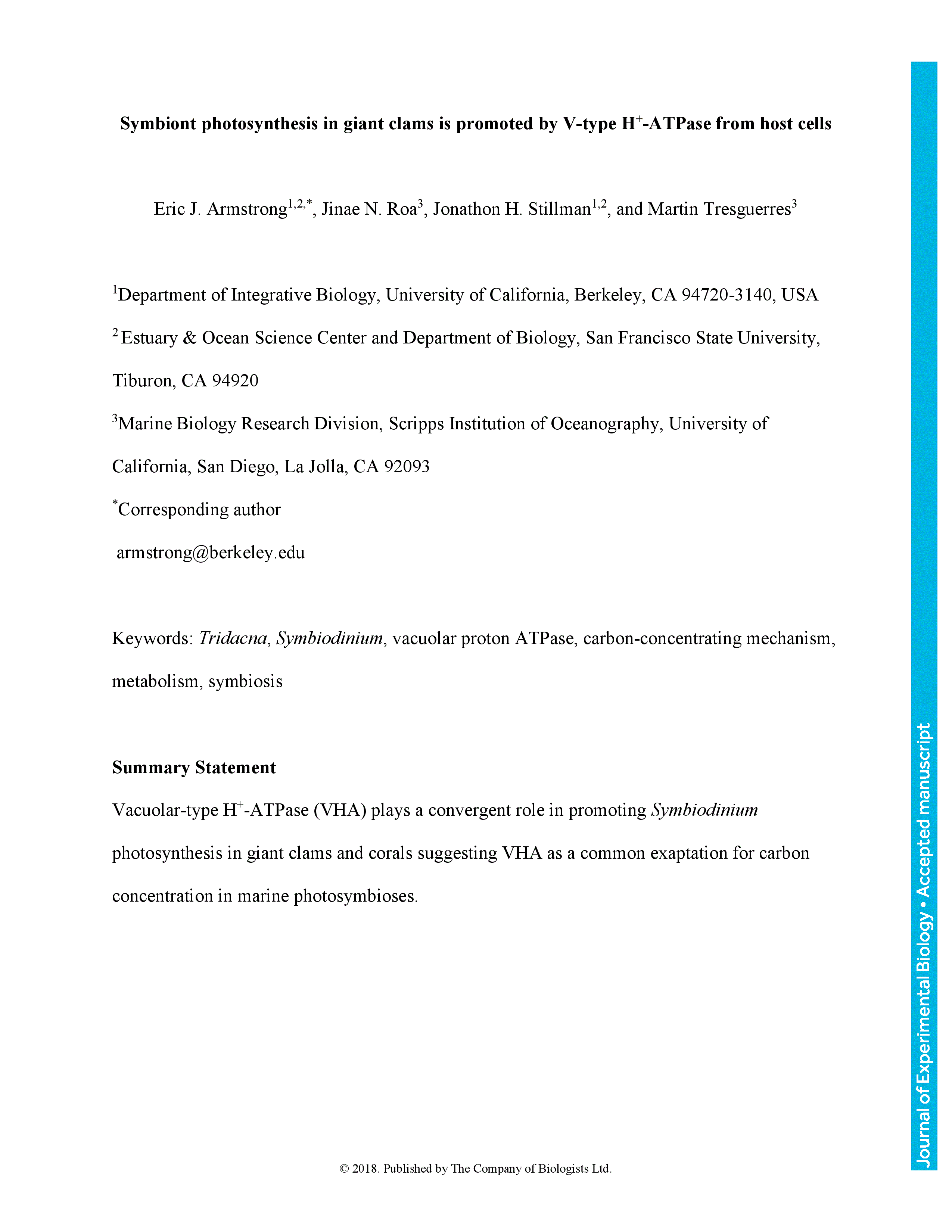Giant clams (genus Tridacna) are the largest living bivalves and, like reef-building corals, host symbiotic dinoflagellate algae (Symbiodinium) that significantly contribute to their energy budget. In turn, Symbiodinium rely on the host to supply inorganic carbon (Ci) for photosynthesis. In corals, host “proton pump” vacuolar-type H+-ATPase (VHA) is part of a carbon concentrating mechanism (CCM) that promotes Symbiodinium photosynthesis. Here, we report that VHA in the small giant clam (Tridacna maxima) similarly promotes Symbiodinium photosynthesis. VHA was abundantly expressed in the apical membrane of epithelial cells of T. maxima’s siphonal mantle tubule system which harbors Symbiodinium. Furthermore, application of the highly specific pharmacological VHA inhibitors bafilomycin A1 and concanamycin A significantly reduced photosynthetic O2 production by ∼40%. Together with our observation that exposure to light increased holobiont aerobic metabolism ∼five-fold, and earlier estimates that translocated fixed carbon exceeds metabolic demand, we conclude that VHA activity in the siphonal mantle confers strong energetic benefits to the host clam through increased supply of Ci to algal symbionts and subsequent photosynthetic activity. The convergent role of VHA in promoting Symbiodinium photosynthesis in the giant clam siphonal mantle tubule system and coral symbiosome suggests VHA-driven CCM is a common exaptation in marine photosymbioses that deserves further investigation in other taxa.
Symbiont photosynthesis in giant clams is promoted by V-type H+-ATPase from host cells
Currently Viewing Accepted Manuscript - Newer Version Available
- Split-screen
- Views Icon Views
- Open the PDF for in another window
-
Article Versions Icon
Versions
- Version of Record 27 September 2018
- Accepted Manuscript 01 January 2018
- Share Icon Share
-
Tools Icon
Tools
- Search Site
Eric J. Armstrong, Jinae N. Roa, Jonathon H. Stillman, Martin Tresguerres; Symbiont photosynthesis in giant clams is promoted by V-type H+-ATPase from host cells. J Exp Biol 2018; jeb.177220. doi: https://doi.org/10.1242/jeb.177220
Download citation file:
Advertisement
2023 JEB Outstanding Paper Prize shortlist and winner

The JEB Editors are delighted to announce the shortlisted authors for the 2023 JEB Outstanding Paper Prize. Read the winning paper - Tiny spies: mosquito antennae are sensitive sensors for eavesdropping on frog calls - by Hoover Pantoja-Sanchez and Brian Leavell from Ximena Bernal's lab at Purdue University, USA.
JEB Science Communication Workshop for ECRs

If you’re an early-career researcher interested in science communication and are attending the SEB Annual Conference in Prague this summer, come a day early and join the JEB Editors at a sci comm workshop to learn the key writing skills needed to promote your research to a broad audience beyond your peers (1 July at 14.30-17.30). Places are limited to 24 attendees, and applicants should apply through the SEB registration page by 30 April 2024.
Bridging the gap between controlled conditions and natural habitats in understanding behaviour

Novel technologies enable behavioural experiments with non-model species, in naturalistic habitats and with underexplored behaviours. In their Commentary, Scholz and colleagues discuss how to obtain a deeper understanding of the natural ecology and lifestyle of study animals.
Beluga metabolic measures could help save species

To help save animals from extinction, it’s important to understand what each species needs to survive. This led Jason John et al. to measure the metabolic rates of captive belugas to develop a ‘fish calculator’ showing that the whales need to eat ~23 salmon per day.
ECR Workshop on Positive Peer Review

Are you an ECR looking for tips on how to write concise, astute and useful manuscript reviews? If so, join the JEB Editors at a 2-hour JEB-sponsored Workshop on Positive Peer Review at the Canadian Society of Zoologists annual meeting in Moncton on 9 May 2024 at 13.00-15.00. There are 25 spaces for ECRs and selection is first come, first serve. To sign up, check the ECR Workshop box when you register for the CSZ meeting.



